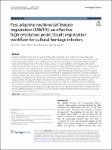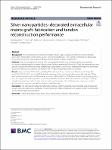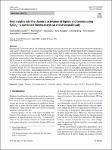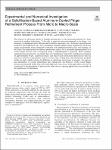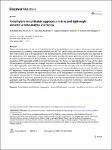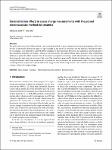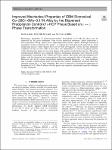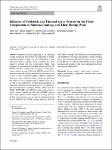Search
Author
- Manyk, T. (3)
- Murawski, K. (3)
- Baumgartner, Jörg (2)
- Guizani, Chamseddine (2)
- next >
Subject
Date issued
- 2023 (187)
Has File(s)
- true (187)
Search Results
Accurate registration of 3D scans is crucial in creating precise and detailed 3D models for various applications in cultural heritage. The dataset used in this study comprised numerous point clouds collected from different rooms in the Museum of King Jan III’s Palace in Warsaw using a structured light scanner. Point clouds from three relatively small rooms at Wilanow Palace: The King’s Chinese Cabinet, The King’s Wardrobe, and The Queen’s Antecabinet exhibit intricate geometric and decorative surfaces with diverse colour and reflective properties. As a result, creating a high-resolution full 3D model require a complex and time-consuming registration process. This process often consists of several steps: data preparation, registering point clouds, final relaxation, and evaluation of ... |
The reconstruction of tendons with large defects requires grafts with high mechanical strength and is often hindered by complications such as infection and adhesion. Hence, grafts combining the advantages of mechanical resilience and antibacterial/antiadhesion activity are highly sought after. |
Engineering of activated carbons (ACs) through chemical activation of organic precursors has been extensively studied for a wide variety of biopolymers, biomasses, wastes and other fossil-based precursors. Despite huge efforts to engineer evermore performant and sustainable ACs, “searching-for-the-best-recipe” type of studies are more the rule than the exception in the published literature. Emerging AC applications related to energy and gas storage require strict control of the AC properties and a better understanding of the fundamentals underlying their engineering. In this study, we provide new insights into the K2CO3 chemical activation of plant-based polyphenols—lignins and tannins—through careful thermoanalytical and structural analyses. We showed for the the first time that th... |
The interest in ultra-pure metals is steadily growing due to the increasing demand for these materials in modern technology. To be able to meet the increasing demand in the future, it is necessary to implement more efficient and productive processes. As a fractional crystallization method in this application area, the cooled finger method exhibits higher productivity and lower energy requirements when compared to industry well-established methods like zone melting. In this study, the mechanisms and relevant phenomena crucial for a successful implementation of a cooled finger process were investigated using a multidisciplinary approach. With carefully selected process parameters, we present here an experimental setup with a purification potential of approximately 80 pct. |
Polyethylene terephthalate aggregates in structural lightweight concrete: a meta-analysis and review There is growing interest in the use of recycled materials in the building sector as a way to reduce waste and improve environmental sustainability. Polyethylene terephthalate (PET) is a thermoplastic polymer that has attracted the attention of researchers due to its application in the building industry. In the recent past, many studies have reported on the application of PET aggregates in structural lightweight concrete. This paper presents a review of the findings of 20 studies conducted between 2010 and 2022 randomly. The preliminary findings highlighted include the method of production of PET aggregates and their physical/thermal properties. The review extended further to focus on the extent of incorporation, physical properties, strength properties, and durability of concrete w... |
Graphene is a suitable transducer for wearable sensors because of its high conductivity, large specific surface area, flexibility, and other unique considerable features. Using a simple, fast galvanic pulse electrodeposition approach, a unique nonenzymatic glucose amperometric electrode was successfully developed based on well-distributed fine Cu nanoparticles anchored on the surface of 3D structure laser-induced graphene. The fabricated electrode allows glucose detection with a sensitivity of 2665 µA/mM/cm2, a response time of less than 5 s, a linear range of 0.03–4.5 mM, and a LOD of 0.023 µM. It also detects glucose selectively in the presence of interfering species such as ascorbic acid and urea. These provide the designed electrode the advantages for glucose sensing in saliva w... |
The pulsed electroacoustic (PEA) method is an established method for space charge measurements in polymeric dielectrics. In view of the poorly understood impact of space charge on the electrical resistivity and the dielectric breakdown behavior of ceramics, it is desirable to adapt the PEA technique to these materials. However, this adaption is non-trivial due to the constitutive properties of ceramics, which are, at least in part, very different from that of polymers. This contribution addresses a particular effect related to the electrostrictive properties of ceramics on the theoretical level. It is shown that these properties may cause an inversion of the sign of the sound wave generated by electrical voltage pulses when compared to typical polymers, which may in turn result in a... |
The weldability of steel under the water is limited due to the influence of the environment. Water causes limited visibility, presence of the residual stresses, increasing the cooling rate, and increasing the diffusible hydrogen content in deposited metal, leading to the formation of brittle microstructures in heat-affected zone (HAZ). The paper presents the results of mechanical properties testing of S420G2+M steel welded joints made with covered electrodes in the water with salinity values: 0‰, 7.5‰, and 35‰. The non-destructive tests: ultrasonic (UT) and radiographic (RT), and destructive tests: Vickers HV10 measurements, Charpy impact, and bending and metallographic macro- and microscopic tests were performed. |
Mechanical properties of electron-beam-melted biomedical Co–Cr–Mo–N alloys can be improved by the grain refinement from reverse transform treatment, which transforms a low-temperature strong ε-phase into a high-temperature ductile γ-phase. Although mechanical properties of alloys consisting of a single ε- or γ-phase have been previously reported on, those comprising mixed ε- and γ-phases have not yet been investigated. Herein, the heat treatment conditions of the Co–28Cr–6Mo–0.11N alloy were determined to control the phase fraction while obtaining fine grains in the mixed phases with superior mechanical properties. The phase transformation behavior was analyzed. Superior mechanical properties were observed in the mixed phases containing 70 pct γ-phase and 30 pct ε-phase. |
Suspension thermal spraying is an emerging coating technology that enables the deposition of dense-structured ceramic coatings. As wear resistance is a main application field of alumina (Al2O3) coatings, this study aimed to evaluate the dry reciprocating sliding wear resistance of suspension sprayed high velocity oxy-fuel (S-HVOF) alumina coatings and to compare it with atmospheric plasma sprayed (APS) and HVOF coatings. Coatings were analyzed in the as-sprayed state and post-treated at 910 °C (hot isostatically pressed, HIPed) conditions. Wear tests were conducted using a tribometer, following the ASTM G133-02 standard and a sintered WC-6 wt.% Co ball as the counterbody. Coating characterization was done using scanning electron microscopy, x-ray diffraction and nanoindentation tech... |

